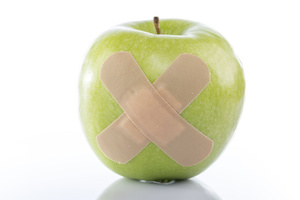
Bullying is a hot topic, be it at school, in the workplace or at home. There is not magic age at which one becomes immune to bullying. Some bullying is easy to see, when the bruises are visible, but even then, many victims choose to downplay their injuries, or protect their abusers, for fear of reprisals and out of a sense of shame.
When people are bullied, they feel horrible inside and sometimes don’t show or tell others how they are feeling. Sadly, they can often start to believe their bully’s words and intentions.
Bullying happens everywhere – on committees, within families, in classrooms, at university, in sports clubs.
One English teacher has illustrated the effects of bullying well using the humble apple. She brought two apples to her class – one of which she had bruised by gently tapping on the floor.
She said, “I picked up the apple I’d dropped on the floor and started to tell the children how I disliked this apple, that I thought it was disgusting, it was a horrible colour and the stem was just too short. I told them that because I didn’t like it, I didn’t want them to like it either, so they should call it names too.
“Some children looked at me like I was insane, but we passed the apple around the circle calling it names, ‘you’re a smelly apple’, ‘I don’t even know why you exist’, ‘you’ve probably got worms inside you’ etc.
“We then passed another apple around and started to say kind words to it, ‘You’re a lovely apple’, ‘Your skin is beautiful’, ‘What a beautiful colour you are’ etc.
“I then held up both apples, and again, we talked about the similarities and differences, there was no change, both apples still looked the same. “I then cut the apples open. The apple we’d been kind to was clear, fresh and juicy inside.
“The apple we’d said unkind words to was bruised and all mushy inside.”
For the children, this lesson was enlightening. They could understand what happens when they mistreat others, and if they had been bullied, why they felt the way they did.
“If we hadn’t have cut that apple open, we would never have known how much pain we had caused it.”
From time to time, everyone has fallouts with others, or goes through times of conflict, but bullying is more insidious than that.
If someone you love, regardless of age, shows any of the following signs, it may be time to see if they are being bullied and need help. Don’t ignore your ‘gut instinct,’ even if at first they claim to be fine, keep a look out for the following behaviours:
- Changes in character, e.g. an outgoing person becoming withdrawn or a shy one becoming aggressive
- Sleeping problems
- Vague or unexplained illnesses which prevent them from going to work or school
- Odd or unexplained marks or bruises which might indicate abuse
- Wishing to avoid certain people or places
- Asking for advice in the third person, e.g. “My friend is being bullied, what should I do?”
- Spending more time online (research indicates even victims of cyber bullying are perversely driven to spend more, not less, time on social media).









Join the Discussion
Type out your comment here:
You must be logged in to post a comment.